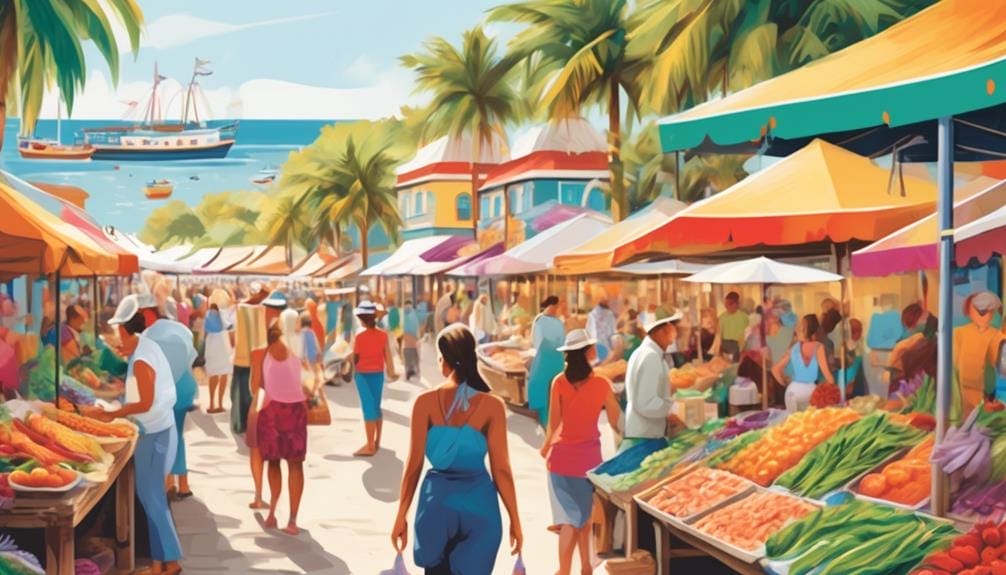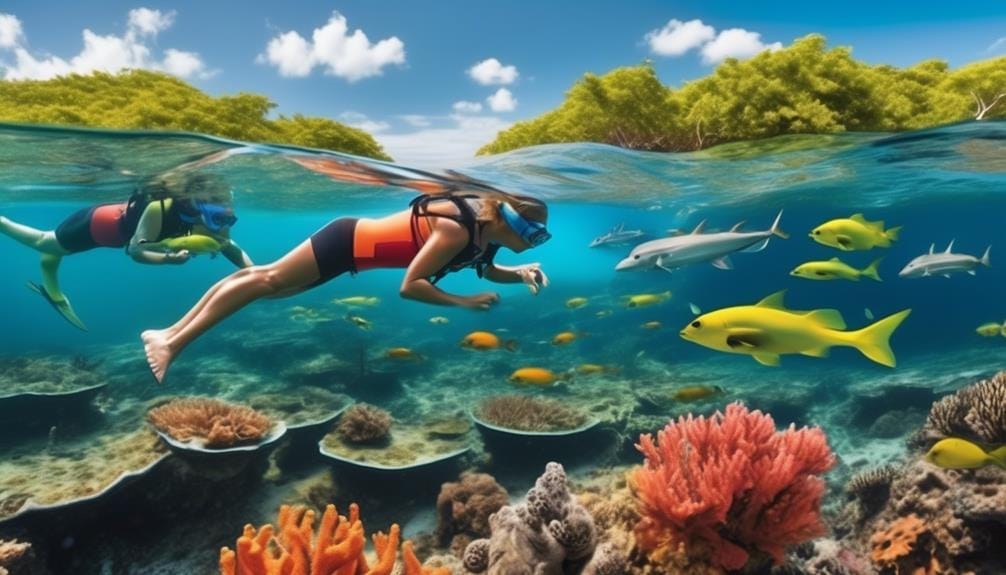Imagine standing on the sandy shores of a pristine beach, the salty breeze caressing your face as you gaze out at the vast expanse of the ocean. The rhythmic sound of waves crashing against the shore fills the air, a symphony of nature's beauty.
Now, imagine being able to explore this coastal paradise while making a positive impact on the environment. Seaside eco-tourism offers you the opportunity to do just that.
But what exactly is seaside eco-tourism, and why should you be intrigued?
Key Takeaways
- Seaside eco-tourism contributes to conservation efforts and protects coastal ecosystems.
- Sustainable accommodation options prioritize renewable energy sources and sustainable practices.
- Marine conservation is important for protecting endangered species and maintaining biodiversity.
- Supporting local communities through eco-friendly practices and volunteering can help promote sustainability in coastal areas.
Benefits of Seaside Eco-Tourism
Seaside eco-tourism offers numerous benefits for both travelers and the environment. By engaging in sustainable activities and supporting eco-friendly businesses, you can contribute to conservation efforts and protect the delicate coastal ecosystem.
When you choose to participate in seaside eco-tourism, you have the opportunity to explore natural attractions such as Grayton Beach State Park, Point Washington State Forest, and the Gulf of Mexico. These areas provide diverse outdoor activities and experiences that allow you to immerse yourself in the beauty of nature while also learning about local ecosystems.
One of the key benefits of seaside eco-tourism is the chance to support the local economy. By patronizing eco-friendly businesses, you help create a demand for sustainable practices, which in turn promotes economic growth while minimizing negative environmental impacts. Additionally, through beach cleanups and other sustainable activities, you can actively contribute to the conservation and preservation of coastal habitats. This allows for the protection of the diverse plant and animal species that call these areas home.
Seaside eco-tourism also provides opportunities for education and awareness. By participating in educational programs, visiting nature centers, and exploring marine habitats, you gain a deeper understanding of the indigenous plants and animals that inhabit these coastal areas. This knowledge fosters an appreciation for the importance of conservation and encourages responsible behavior towards the environment.
Furthermore, by embracing sustainable transportation options like bicycles, public transportation, and carpooling, you can reduce carbon emissions and support initiatives for eco-friendly travel. This not only benefits the environment but also enhances the overall experience of your seaside eco-tourism trip by allowing you to connect more intimately with the local surroundings.
Sustainable Accommodation Options
When it comes to sustainable accommodation options for your seaside eco-tourism adventure, there are various choices available.
You can opt for eco-friendly lodges, resorts, and hotels that prioritize renewable energy sources and sustainable practices. These environmentally conscious accommodations not only provide a comfortable stay but also promote water-saving and energy-efficient practices, along with offering organic and locally sourced meals for a truly eco-friendly experience.
Eco-Friendly Lodging Options
Eco-friendly lodging options in seaside destinations provide travelers with green-certified, energy-efficient accommodations and sustainable practices that promote environmental conservation. When choosing eco-friendly lodging options, consider the following:
- Green-certified accommodations: These establishments have met specific standards and certifications, ensuring their commitment to sustainable practices. Look for certifications like LEED (Leadership in Energy and Environmental Design) or Green Key.
- Renewable energy sources: Many eco-friendly lodgings use renewable energy sources such as solar or wind power to reduce their carbon footprint.
- Locally sourced meals: Sustainable accommodations often prioritize organic, locally sourced meals, supporting local farmers and reducing the environmental impacts associated with long-distance food transportation.
- Eco-friendly activities and transportation: Choose accommodations that offer sustainable activities like beach cleanups, eco-tours, and educational programs. Additionally, consider lodging options that promote eco-friendly transportation methods like bicycles, public transport, or carpooling.
Sustainable Resorts and Hotels
As we continue our exploration of sustainable lodging options in seaside destinations, let's now turn our attention to the world of sustainable resorts and hotels.
These accommodations offer eco-friendly alternatives for environmentally-conscious travelers. Sustainable resorts and hotels prioritize sustainability by implementing green practices and obtaining certifications to ensure their commitment to the environment. They utilize renewable energy sources, such as solar panels or wind turbines, and employ water-saving techniques to minimize their ecological footprint.
Moreover, guests staying in sustainable resorts and hotels can actively participate in sustainable activities, including beach cleanups, eco-tours, and learning about conservation efforts. These accommodations also offer organic and locally sourced meals, allowing visitors to indulge in sustainable dining experiences.
Additionally, guests can engage with the local ecosystems through educational programs, nature centers, and guided nature walks. Sustainable transportation options, such as bicycles and eco-friendly choices, are readily available for guests to explore surrounding areas.
Environmentally Conscious Accommodations
To promote sustainable tourism, consider staying at environmentally conscious accommodations that prioritize green practices and offer a range of eco-friendly amenities. These accommodations strive to reduce their environmental impact and contribute to the preservation of seaside ecosystems.
Here are four key features to look for in environmentally conscious accommodations for your seaside eco-tourism experience:
- Green certifications: Choose accommodations that have obtained recognized green certifications, ensuring that they meet specific environmental standards.
- Renewable energy sources: Look for accommodations that utilize renewable energy sources, such as solar or wind power, to minimize their carbon footprint.
- Water-saving practices: Opt for accommodations that implement water-saving measures, such as low-flow showerheads and toilets, to conserve this precious resource.
- Organic, locally sourced meals: Support accommodations that prioritize organic and locally sourced meals, reducing the carbon footprint associated with food transportation and supporting local farmers.
Conservation Efforts for Marine Life
Conservation efforts for marine life encompass a range of strategies, including the establishment of protected marine areas, implementation of sustainable fishing practices, and reduction of plastic pollution, all aimed at preserving the delicate balance of the ocean ecosystem.
| Strategy | Description |
|---|---|
| Protected Marine Areas | These designated zones serve as sanctuaries for marine species by limiting human activity and providing a safe haven for their survival. Protected areas also promote biodiversity and serve as important breeding grounds for various species, including sea turtles. |
| Sustainable Fishing Practices | Responsible fishing methods, such as using selective gear and avoiding overfishing, help maintain healthy fish populations and prevent the depletion of marine resources. By implementing sustainable practices, we can ensure the long-term viability of seafood and protect the habitats that sea turtles and other marine creatures rely on. |
| Plastic Pollution Reduction | Plastic pollution poses a significant threat to marine life, including sea turtles, as they often mistake plastic debris for food or become entangled in it. Efforts to reduce plastic pollution involve proper waste management, promoting recycling, and advocating for the use of eco-friendly alternatives to single-use plastics. By addressing this issue, we can safeguard the health of our oceans and protect the habitats of sea turtles. |
Conservation organizations play a vital role in monitoring and protecting endangered marine species, such as sea turtles, dolphins, and corals. Through research and conservation programs, these organizations gather valuable data on the population status, migration patterns, and habitat requirements of these species. Restoration projects, such as coral reef rehabilitation and mangrove reforestation, are also crucial to maintaining biodiversity and supporting the health of marine ecosystems. These initiatives create suitable habitats for various marine organisms, including sea turtles, and contribute to the overall resilience of the marine environment.
Education and community engagement are key components of marine conservation efforts. By raising awareness about the importance of marine conservation and the threats faced by species like sea turtles, we can inspire individuals to take action and make informed decisions that minimize their impact on the ocean. Collaborative efforts between governments, non-profit organizations, and local communities are crucial in establishing and enforcing regulations that safeguard marine habitats and wildlife. By working together, we can ensure the long-term survival of sea turtles and other marine species, while also promoting sustainable and responsible tourism practices.
Supporting Local Communities

Supporting local communities is crucial for the sustainable growth and conservation of seaside eco-tourism destinations. By actively engaging with and supporting local businesses and organizations, you can contribute to the overall well-being of the community and the protection of its natural resources.
Here are four ways you can support local communities:
- Support eco-friendly businesses: Choose to patronize local businesses that prioritize sustainability and environmentally-friendly practices. By doing so, you're directly contributing to the local economy while supporting initiatives that promote the long-term health of the community and its ecosystems.
- Opt for green accommodations: When planning your stay, look for accommodations that have green certifications and utilize renewable energy sources. By staying in eco-friendly establishments, you aren't only reducing your environmental impact but also encouraging the development of more sustainable tourism practices.
- Volunteer for conservation efforts: Participate in beach cleanups and volunteer for local environmental organizations. By actively engaging in these activities, you can directly contribute to the conservation and preservation of the coastal ecosystem. Your efforts will help maintain the beauty and health of the area for future generations to enjoy.
- Promote sustainable transportation: Use bicycles or electric scooters for local travel and support initiatives for bike lanes and pedestrian-friendly infrastructure. By prioritizing sustainable transportation options, you can reduce carbon emissions, promote healthy lifestyles, and contribute to the development of a more sustainable and livable community.
Eco-Friendly Transportation Options
By prioritizing sustainable transportation options, you can further contribute to the overall well-being of seaside communities and the conservation of their natural resources. Eco-friendly transportation options play a crucial role in reducing carbon emissions and minimizing the environmental impact of travel. Consider using bicycles or electric scooters for local travel, allowing you to enjoy the scenic surroundings while reducing your carbon footprint. Opting for public transportation or carpooling also significantly reduces the ecological footprint of transportation by maximizing the use of existing resources.
To facilitate eco-friendly transportation, it is important to support initiatives for bike lanes and pedestrian-friendly infrastructure. These measures promote safe and convenient travel options while reducing reliance on cars. By advocating for such infrastructure, you can contribute to the development of sustainable transportation networks in seaside communities.
Another way to support eco-friendly transportation is by offsetting carbon emissions from travel. Many organizations offer carbon offset programs where you can invest in projects that reduce greenhouse gas emissions elsewhere, effectively neutralizing the environmental impact of your travel.
Remember, every choice you make regarding transportation has an impact. By consciously choosing eco-friendly transportation options, you can support sustainable travel initiatives and contribute to the preservation of the natural beauty of seaside communities. Table 1 illustrates some eco-friendly transportation options:
| Transportation Option | Benefits |
|---|---|
| Bicycles | – Zero carbon emissions<br>- Promotes physical activity<br>- Allows exploration of scenic surroundings |
| Electric Scooters | – Low carbon emissions<br>- Convenient for short distances<br>- Reduces reliance on cars |
| Public Transportation | – Decreases traffic congestion<br>- Reduces carbon emissions<br>- Cost-effective |
| Carpooling | – Shares transportation resources<br>- Reduces carbon emissions<br>- Builds community connections |
Table 1: Eco-friendly transportation options for sustainable travel in seaside communities.
Make a conscious choice to prioritize eco-friendly transportation options and contribute to the conservation of natural resources for future generations.
Responsible Water Sports and Activities

Engage responsibly in water sports and activities by choosing eco-friendly options that minimize disturbance to wildlife and vegetation. Here are some ways you can enjoy the water while protecting the natural environment:
- Opt for kayaking or airboat tours: These activities allow you to explore the waterways without causing harm to the fragile ecosystems. Companies that offer these eco-friendly options prioritize conservation efforts and often provide educational experiences about the local flora and fauna.
- Support sustainable beachfront accommodations: Choose accommodations that prioritize sustainable practices, such as using renewable energy sources and implementing water-saving and energy-efficient measures. By staying at these establishments, you contribute to the protection of coastal habitats.
- Participate in coastal wildlife bike tours or salt marsh nature and dolphin tours: These tours provide an opportunity to learn about unique ecosystems and their inhabitants while minimizing your environmental impact. By using non-motorized transportation, you can enjoy the sights and sounds of nature without disturbing the delicate balance.
- Book responsible water activities like Sea Turtle Dawn Patrol: By participating in activities focused on sea turtle conservation, you not only experience the thrill of spotting these magnificent creatures in their natural habitat but also contribute to their preservation. These activities adhere to strict guidelines to ensure the safety and well-being of sea turtles.
Eco-Tourism in Coastal National Parks
Coastal National Parks offer a multitude of opportunities for eco-tourism, allowing visitors to immerse themselves in the wonders of nature while actively contributing to conservation efforts. These parks encompass a range of natural attractions and activities, including visits to state parks, forests, and preserves, as well as exploration of the Gulf of Mexico.
To engage in sustainable practices, visitors can participate in beach cleanups, support local eco-friendly businesses, take eco-tours, and volunteer for environmental organizations. Additionally, eco-friendly accommodations are available within coastal national parks, such as eco-lodges or resorts with green certifications, renewable energy sources, water-saving practices, and locally sourced meals.
When visiting these parks, visitors have the opportunity to learn about local ecosystems through educational programs, nature centers, eco-workshops, and by exploring marine habitats and indigenous plants and animals. By gaining knowledge, visitors can develop a deeper appreciation for the importance of conservation and become advocates for protecting these fragile ecosystems.
Furthermore, sustainable transportation options are encouraged within coastal national parks. Visitors can opt for bicycles, electric scooters, or public transportation while also supporting initiatives for eco-friendly transportation.
Exploring Seaside Wildlife and Habitats

Visitors to coastal national parks can further their exploration by immersing themselves in the diverse wildlife and habitats found along the seaside. As part of your seaside eco-tourism experience, consider the following activities:
- Explore Natural Attractions: Grayton Beach State Park, Point Washington State Forest, Topsail Hill State Preserve, St. Andrews State Park, and the Gulf of Mexico offer a range of natural wonders to discover. From pristine beaches to serene forests, these areas provide habitats for a variety of species.
- Engage in Sustainable Activities: Support the conservation efforts of these parks by participating in beach cleanups, eco-tours, and volunteering for environmental organizations. By engaging in these activities, you contribute to the preservation of the fragile ecosystems found along the coast.
- Choose Eco-Friendly Accommodations: Opt for accommodations with green certifications, renewable energy sources, and water-saving and energy-efficient practices. Enjoy organic and locally sourced meals, reducing your carbon footprint while supporting sustainable businesses.
- Learn About Local Ecosystems: Take advantage of educational programs, nature centers, and museums to deepen your understanding of marine habitats and indigenous plants and animals. Discover the intricate web of life that exists in these fragile environments.
One notable destination for exploring seaside wildlife and habitats is Shell Island. This undeveloped barrier island boasts pristine white sand beaches, dunes, and coastal marshes teeming with wildlife. From sea turtles and shorebirds to dolphins and manatees, Shell Island offers a glimpse into the rich biodiversity that can be found in coastal ecosystems.
Responsible Dining and Local Cuisine
To support responsible dining and embrace the local cuisine, it's recommended to choose restaurants that prioritize sustainable, locally sourced ingredients. By opting for organic and locally sourced meals, you not only contribute to the preservation of the environment but also support the local economy. These restaurants often work closely with farmers, fishermen, and other local producers, ensuring that the ingredients used in their dishes are fresh, seasonal, and grown or harvested in a sustainable manner.
When dining responsibly, you can also learn about the indigenous plants and animals that are integral to the local cuisine. Many eco-friendly restaurants provide information about the ingredients used in their dishes, allowing you to appreciate the biodiversity of the region and the traditional knowledge associated with it. By experiencing the local cuisine, you can gain a deeper understanding of the cultural heritage and culinary traditions of the area.
Furthermore, by choosing eco-friendly dining options, you can reduce your environmental impact. Sustainable restaurants prioritize practices such as waste reduction, energy efficiency, and water conservation. They may also offer vegetarian or plant-based options, which have a lower carbon footprint compared to meat-based dishes. Supporting these businesses not only benefits the environment but also encourages others to adopt sustainable practices.
Frequently Asked Questions
What Is an Eco Tourism Vacation?
An eco-tourism vacation is a sustainable getaway that allows you to explore natural attractions while minimizing your impact on the environment. Stay in eco-friendly accommodations and engage in activities that support conservation efforts.
Where Do Eco Tourists Go?
You, as an eco tourist, venture to the top destinations, immersing yourself in the wonders of nature. From pristine beaches to lush forests, you explore and support sustainable practices, leaving a positive impact on the environment.
Does Eco Tourism Work?
Eco-tourism can have a sustainable impact by promoting conservation, supporting local communities, and raising awareness about environmental issues. However, its effectiveness depends on factors like responsible management, visitor education, and minimizing negative impacts on ecosystems.
Conclusion
In conclusion, engaging in seaside eco-tourism offers a unique opportunity to immerse yourself in the wonders of coastal destinations while contributing to their preservation.
By supporting local eco-friendly businesses, participating in conservation efforts, and enjoying responsible water sports and activities, you can help protect marine life and habitats.
With sustainable accommodations, eco-tours, and responsible dining options, you can experience the beauty of seaside wildlife while minimizing your environmental impact.
Embrace the harmony of nature and conservation through seaside eco-tourism.





